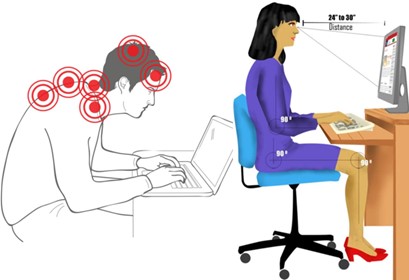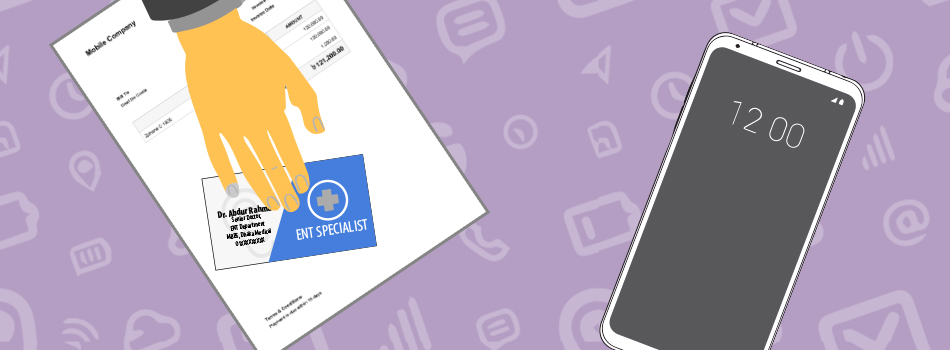
Neck pain? Could your phone be the culprit?
published : 23 October 2023
Neck pain? Could your phone be the culprit?
Like most teenagers and adults these days, 17-year-old Sonia is constantly on her phone. When she is not on the phone, she is lying on her bed with her laptop, endlessly scrolling through social media pages, or watching videos on youtube. This has led her to experience severe neck pain that began radiating down into her shoulder, arm, and fingers. Her muscles are severely spasmodic and several vertebral segment’s facet joints are locked making it impossible and painful to move in and out of position.
14-year-old Leon spends 12-15 hours hunched over in front of the screen playing video games. Leon is receiving physical therapy treatment for severe headaches and pain in the neck and shoulder area. Both Sonia and Leon are now receiving physical therapy for their neck pain and also trying to break their habit and dependency on their digital devices.
Overuse of devices is physically hurting us
Neck pains are one of the most common conditions treated by physical therapists. Unfortunately, we are seeing more and more younger patients seeking treatment for neck pain due to the overuse of smartphones and other digital devices, said Dr. Tazia Sardar, Senior Physical Therapy consultant at Back in Motion.
According to reviews.org’s 2023 data, we spend on average 4 hours and 25 minutes on our smartphones daily, check our phones 144 times a day, and 75% of us use our phones while on the toilet. If you are like most people, your smartphone is the first thing you check when you wake up in the morning, and the last thing you check before you sleep.

Excessive use of devices is harming us physically (source: https://medscape.com)
The result? More neck Pain, spasm, soreness, headache, and in severe cases nerve compression, disc herniation resulting in numbness, tingling, or weakness that radiates down into the arms and the shoulder regions, says world-renowned cervical spine surgeon and co-director of Och Spine at New York- Presbyterian/ Weill Cornell Medical Center.
How does your screen time increases neck strain/pain?
Forward head posture is one of the common presentations in persons with prolonged device use that results in neck pain and other debilitating issues. Forward head posture changes the natural curve of our cervical spine and increases the gravitational force applied to the neck resulting in increased tension felt on the neck, shoulder, and back muscles.
The human head weighs roughly 5kg/~10lbs. The head, sitting on the neck, consisting of 7 cervical vertebrae, can just about support that much weight. For every 15 degrees of forward tilting (equaling to an inch of forward tilt tilting) the pressure felt on the neck doubles and by the time you’re stretched out front by a mere couple of inches, (i.e: if you are looking at your phone on your lap) ( 60 degrees/27kgs), your ten lbs head now feels more like a 40 lbs heavy weight on your cervical spine.
To put this theory to the test: try holding a big watermelon or 5-kilo bag of potatoes close to your chest. It may feel heavy but you will be able to do hold it for quite some time. But what happens if you now extend your arm out in front of you and hold that same bag of potato? Did you notice how it became harder to hold that same amount of weight in front of you instead of close to your chest? That is exactly what happens to our neck and shoulder muscles and vertebral joints as we continuously challenge them to carry weight beyond their maximal capacity. All of that added extra pressure day in and day out puts strain on your spine and can over time pull it out of alignment, even cause degeneration.
4 ways to modify device usage so that it doesn’t cause pain in the long run
It would be impractical to suggest that we simply toss the devices we are tethered to simply because it's proven to be a health hazard. However, there are ways we can modify our usage so that our device is less strenuous on our body. Plenty of options are available nowadays to help us cut back our time staring at our devices such as: turning off notifications, downgrading to a 'dumb' phone, uninstalling all but the most essential apps, using time tracking tools to limit usage, and so on. Below are some tools that are most effective!
1. Going Gray!
One of the simplest and most effective ways to cut back on your screen time is to turn your phone's display setting to “Grayscale” mode. Doing so, removes all color from the screen and is a more effective deterrent than you might think. The idea is to make your phone less fun to use- your phone becomes more like a tool, than a toy. In Grayscale mode, Instagram becomes a river of drab grayness, web articles are bland to the point of boring, and games loose all their visual appeal.
Humans are simple beings- our brain gets excited by color and is attracted to anything bright and shiny. Silicon Valley knows this well and uses it to their advantage when they design a consumer product! Former Google design ethicist and now the co-founder of Center for Humane Technology, Tristan Harris, says going grayscale removes positive reinforcements and dampens that urge to keep loading up social media feeds and mobile games. And if you are a parent who is constantly struggling to keep young children away from the devices, this trick will work wonders.
Not an Apple user? No problem! The grayscale toggle switch is part of a new Digital Wellbeing suite of tools built into the latest versions of Android phones and Samsung has its own version as well.
2. Set up mental blocks
Next time you feel the urge to reach for your phone to check for any incoming messages, or check social media news feeds and updates, Catherine Price, the author of “How to Break Up With Your Phone,” suggests setting up mental speed bumps so that you would be forced to think and make conscious decision about your phone usage. For example, put a rubber band around your phone and change your lock screen that displays the following three questions:
“What for? Why now? Can it wait?”
If the answer to the last question is “yes” then put down your phone and find something else to distract you from the moment’s urge. Silicon Valley is in a battle for our attention, and answering these questions before using our phone will give us a tangible control over the time and attention we give to our shiny devices instead of falling prey to their trap.
3. Stand up, sit less

If you are already experiencing neck or back pain or want to avoid having these physical issues, make your workspace more ergonomic.
Adding Standing desks which are adjustable allows you to stand up while working at least for some part of the day. They are becoming more popular and promote good health.
Swapping your chair for a Physioball will reduce the forward head posture we are prone to developing from prolonged device usage. Paying attention to your posture throughout the day, whether sitting or standing, can help to reduce some of the strains of screen time. A natural, upright posture (with slight curves in the lower back and shoulders) helps to support your head and reduces fatigue and aches.
4. Do Desk Yoga :
Here are a few movements you can do while working at your desk, or studying.

Do desk yoga ( source: https://yogahub.life)
Tech Neck tension relief yoga!
- Seated neck roll - hold for 5 sec, repeat 10x
- Seated forward bend - hold for 5-10 sec, repeat 10x
- Seated reverse prayer-hold for 5-10 sec, repeat 5 times
- Seated cow face pose - hold for 5-10 sec, repeat 10 times
- Seated spinal twist - hold for 5-10 sec, repeat 10 times
Living in the 21st century, use of technology is inevitable. Being a conscious consumer of technology will keep us physically, mentally socially and spiritually healthy.


















